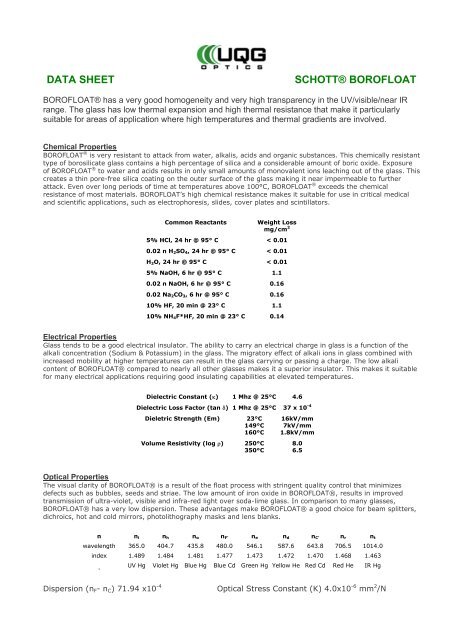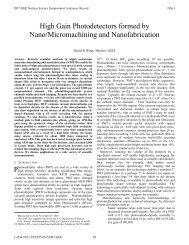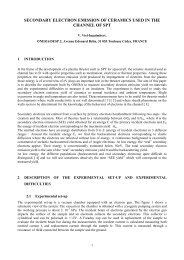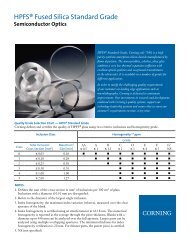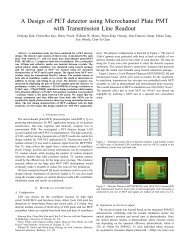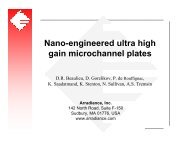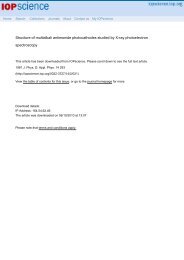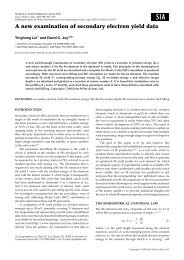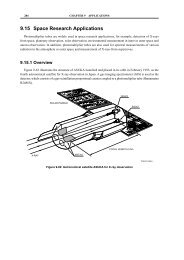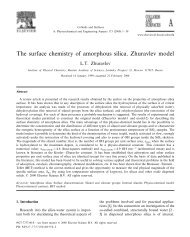DATA SHEET SCHOTT BOROFLOAT
DATA SHEET SCHOTT BOROFLOAT
DATA SHEET SCHOTT BOROFLOAT
You also want an ePaper? Increase the reach of your titles
YUMPU automatically turns print PDFs into web optimized ePapers that Google loves.
<strong>DATA</strong> <strong>SHEET</strong><strong>SCHOTT</strong>® <strong>BOROFLOAT</strong><strong>BOROFLOAT</strong>® has a very good homogeneity and very high transparency in the UV/visible/near IRrange. The glass has low thermal expansion and high thermal resistance that make it particularlysuitable for areas of application where high temperatures and thermal gradients are involved.Chemical Properties<strong>BOROFLOAT</strong> ® is very resistant to attack from water, alkalis, acids and organic substances. This chemically resistanttype of borosilicate glass contains a high percentage of silica and a considerable amount of boric oxide. Exposureof <strong>BOROFLOAT</strong> ® to water and acids results in only small amounts of monovalent ions leaching out of the glass. Thiscreates a thin pore-free silica coating on the outer surface of the glass making it near impermeable to furtherattack. Even over long periods of time at temperatures above 100°C, <strong>BOROFLOAT</strong> ® exceeds the chemicalresistance of most materials. <strong>BOROFLOAT</strong>’s high chemical resistance makes it suitable for use in critical medicaland scientific applications, such as electrophoresis, slides, cover plates and scintillators.Common ReactantsWeight Lossmg/cm 25% HCl, 24 hr @ 95° C < 0.010.02 n H 2 SO 4 , 24 hr @ 95° C < 0.01H 2 O, 24 hr @ 95° C < 0.015% NaOH, 6 hr @ 95° C 1.10.02 n NaOH, 6 hr @ 95° C 0.160.02 Na 2 CO 3 , 6 hr @ 95° C 0.1610% HF, 20 min @ 23° C 1.110% NH 4 F*HF, 20 min @ 23° C 0.14Electrical PropertiesGlass tends to be a good electrical insulator. The ability to carry an electrical charge in glass is a function of thealkali concentration (Sodium & Potassium) in the glass. The migratory effect of alkali ions in glass combined withincreased mobility at higher temperatures can result in the glass carrying or passing a charge. The low alkalicontent of <strong>BOROFLOAT</strong>® compared to nearly all other glasses makes it a superior insulator. This makes it suitablefor many electrical applications requiring good insulating capabilities at elevated temperatures.Dielectric Constant (κ) 1 Mhz @ 25°C 4.6Dielectric Loss Factor (tan δ) 1 Mhz @ 25°C 37 x 10 -4Dieletric Strength (Em) 23°C149°C160°CVolume Resistivity (log ρ) 250°C350°C16kV/mm7kV/mm1.8kV/mm8.06.5Optical PropertiesThe visual clarity of <strong>BOROFLOAT</strong>® is a result of the float process with stringent quality control that minimizesdefects such as bubbles, seeds and striae. The low amount of iron oxide in <strong>BOROFLOAT</strong>®, results in improvedtransmission of ultra-violet, visible and infra-red light over soda-lime glass. In comparison to many glasses,<strong>BOROFLOAT</strong>® has a very low dispersion. These advantages make <strong>BOROFLOAT</strong>® a good choice for beam splitters,dichroics, hot and cold mirrors, photolithography masks and lens blanks.n n i n h n g n F’ n e n d n C’ n r n twavelength 365.0 404.7 435.8 480.0 546.1 587.6 643.8 706.5 1014.0index 1.489 1.484 1.481 1.477 1.473 1.472 1.470 1.468 1.463. UV Hg Violet Hg Blue Hg Blue Cd Green Hg Yellow He Red Cd Red He IR HgDispersion (n F - n C ) 71.94 x10 -4 Optical Stress Constant (K) 4.0x10 -6 mm 2 /N
1009590858075706560555045403530252015105Transmission (%)<strong>BOROFLOAT</strong>® Transmission CurveGlass Thickness: 0.7, 2, 5, 9 and 19mm00 500 1000 1500 2000 2500 3000 3500 4000 4500 5000Wavelength (nm)Physical PropertiesThe density of <strong>BOROFLOAT</strong>® is one of the lowest for silicate-based glasses. <strong>BOROFLOAT</strong>® has extremely goodabrasion and scratch resistance. As with all glass the bending strength of <strong>BOROFLOAT</strong>® is influenced by thesurface condition of the glass part, the rate at which the load is applied and the area on the glass part placedunder load.Density(ρ) @25°C 2.22 g/cm3Young's Modulus (E) @25°C 63 GPaKnoop Hardness (HK 0.1/2.0) per ISO 9385 480Poisson's Ratio (µ) 0.20Bending Strengthper DIN 52292 25 N/mm2Thermal Properties<strong>BOROFLOAT</strong> ® has one of the lowest coefficients of thermal expansion for conventional glass materials, thisprovides <strong>BOROFLOAT</strong> ® with good thermal shock resistance. Combined with a maximum long term use temperatureof 450°C, which makes <strong>BOROFLOAT</strong> ® a good choice for applications requiring good thermal stability.Coefficient of Thermal Expansion (α 20 - 300° C ) 3.25 x 10 -6 /KThermal Conductivity(λ) 10°C50°C90°C190° C1.11 W/m K1.17 W/m K1.22 W/m K1.31 W/m KHeat Capacity(Cp) 20 - 100°C 0.83 kJ/kg KMaximum Operating TemperatureResistance to Thermal GradientsResistance to Thermal ShockShort-termLong-term< 1 hour1 - 100 hours> 100 hours< 4 mm4-6 mm6-15 mm> 15 mm500°C450°C110K90K80K175K160K150K140KWHILE EVERY ATTEMPT HAS BEEN MADE TO VERIFY THE SOURCE OF THE INFORMATION, NORESPONSIBILITY IS ACCEPTED FOR ACCURACY OF <strong>DATA</strong>.UQG LTD, THE NORMAN INDUSTRIAL ESTATE, 99-101 CAMBRIDGE ROAD, MILTON, CAMBRIDGE,CB4 6AT, ENGLAND. TEL: +44 (0) 1223 420329 FAX: +44 (0) 1223 420506


